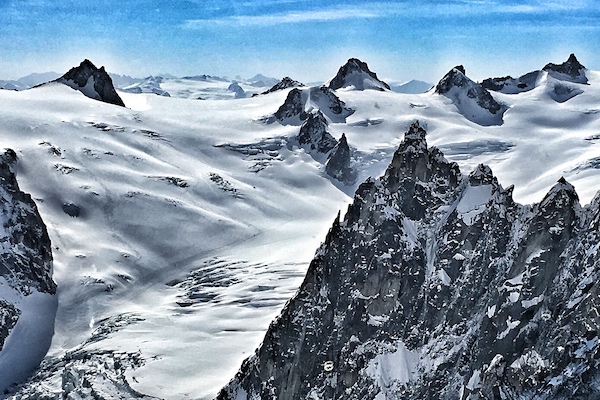
31 Aug How to climb Mont Blanc: the process
This is the second in a series of two blogs on how to climb the Mont Blanc. Here I a link to the first one:https://swisskisafari.com/climbing-the-mont-blanc-what-you-need-to-know/
There are two main routes available to climb Mont Blanc. While neither could be called easy, one is less risky than the other.
The less-technical route to climb Mont Blanc begins with a very dangerous first section: a traverse across a famous face to reach a refuge. It’s common to experience loose, falling rocks here and other climbers can exacerbate this by mistake. Renowned for its high death toll, this perilous traverse is done one person at a time, often without a rope. Loose rocks can injure you or destabilize your footing, so having a very experienced guide here is crucial.
Steeper and more technical, the second trail has more exposed sections. Long stretches of this route cross a steep snow face with unstable seracs overhead. This is particularly dangerous when the face is icy. Climbers must be prepared to abandon a summit attempt if there is too much blue ice as these conditions can be seriously risky. In these circumstances, there will be no guarantees that your guide will be able to hold you if you lose your footing.
Only climb Mont Blanc in appropriate weather
· Thick snow will make your ascent physically much more challenging as you’ll need to create your own path through it. When faced with heavy snow your guide may be the one making the initial track, but the second in line will still need to work hard to make progress.
· Blue ice will make the terrain dangerous and add a significant amount of time to your route. Each step will need to be taken more delicately as your footing will be less sure.
· Working in high winds will mean using more energy, plus it will affect your balance across exposed ridges. Wind can also cause steep temperature drops, making your progress harder.
· Good visibility can turn bad very quickly, impacting your safety. Bad visibility combined with wind will affect your attempt to climb Mont Blanc and may terminate your chances of getting to the top.
· Beware of rock fall. Even the smallest rock traveling at high speed can cause damage if it hits you. Even if a falling rock doesn’t touch you it can still throw your balance off and risk you losing your footing.
· Big seracs in some areas can fall at any moment and are unpredictable. Imagine tons of ice crashing down with no warning.
· Crossing steep snow faces is tricky, and sometimes your guide cannot assure you completely in these areas. Where your guide would usually aim to secure you from a fixed point above the face with a rope, when a face is very steep this cannot be done from above.
Your Mont Blanc guide
A good, experienced guide will want to assess your fitness and risk level themselves rather than rely on your opinion. This means taking time to experiment in the mountain environment before working out whether you are ready to climb Mont Blanc. This is a sign of experience and is crucial to look for when choosing a guide. After a mountain assessment your guide will offer honest feedback about your abilities, not hesitating to tell you if you are ready or not. Any decision made is for your safety and the safety of the group.
How long will a Mont Blanc summit take?
Ideally your attempt to climb Mont Blanc should take 5 -7 days in total including preparation days, depending on your fitness level and previous mountain experience. It should certainly be no less than 5 days, irrespective of your level.
An experienced guide will ask you to dedicate time to your summit attempt, not just attempt it in two days. This is a sign of a knowledgeable guide, so look for this. Your trip should include a few days of preparation before the summit, as, put simply, more time on the mountain means you are more likely to reach the top.
For those with a passion for the mountains and who are ready for the next challenge, to climb Mont Blanc can be an exceptional experience. But it is critical to go into this venture well-informed and with your eyes open. The Mont Blanc is a dangerous mountain and doing it without sufficient preparation puts you and your guide at risk. Why do that for something that is meant to bring you pleasure and joyful achievement?
Warm regards from the mountains,
Danielle


